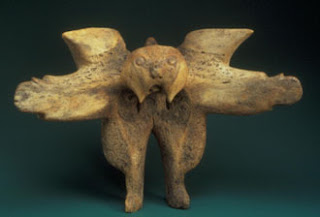Random round-up
 Eli Inukpaluk, Shaman with a Bird Spirit, 1967-1968. Whalebone. From the Albrecht Collection at the Heard Museum. Image found here.
Eli Inukpaluk, Shaman with a Bird Spirit, 1967-1968. Whalebone. From the Albrecht Collection at the Heard Museum. Image found here.
Just some things I've made note of or have posted elsewhere over the past couple of days . . .
The piece pictured here is displayed at the entrance to the Wichita Art Museum's new exhibition, Arctic Spirit: Inuit Art from the Albrecht Collection at the Heard Museum. There are a few things I'd like to say about this exhibit in a separate post, but for now I'll just say to local folks that this show is well worth going to see: it's a glimpse, through its recent art, of a culture few of us this far south of the treeline will ever know much about. It'll be here in town till July 20th. As for other folks who visit this blog, I know some of you will be within range of its future stops: Richmond, Virginia; Mashantucket, Connecticut; and Baton Rouge, Louisiana. Click on the link in the image credit to see the schedule.
More below the fold.
Maybe I was the last person in the film-going world to have seen Das Boot; but if you are now not yet that last person, then you need to do something about that. Steve Soderbergh once said of The Third Man that it is one of those films that you've always heard is great and is even better than people say it is; I'd have to say Das Boot is in that same category. Also, if at all possible you'll want to watch it with a Dolby 5.1 sound system: the loud stuff is powerful, but it's the sound during the quiet moments that you'll want to hear coming from all sides and behind you: the creaking of the U-boat's sides as the ocean exerts its pressure on the boat, the sounds of the water lapping against the boat, the slow drips from leaks as water finds its way through the seams . . . it's in the detail of those sounds that, along with the claustrophobia-inducing dimensions of the sub-sized set, sells this film's realism and heightens its drama. Oh, the plot? It could not be simpler or, in its way, more familiar; all you need to know is that this film's power is such that it won't be long before you've forgotten that these are Nazi soldiers you're cheering on.
Finally, over at Domestic Issue: some more pictures, including three very different depictions of the woman known as La Malinche, Cortés' interpreter and the mother of a child by Cortés regarded symbolically as the first mestizo; lots more online sites (many of which have still more pictures--as just one example, anyone curious about antebellum-era depictions of the slave trade and slave and freed-black life in this country will want to visit this visually-rich site hosted by the University of Virginia; and a long post in which I address not only the essence of what my book project will be about but also various problems I'll have to negotiate along the way.































3 comments:
Re: Das Boot.
I new an exchange student from Kiel whose father was a U-Boat officer. He saw the film and told her that it was an extraordinarily accurate portrayal of the life in the U-Boat fleet with one exception: the smells. When they would return to France, or later Norway, the maintenance crews would have to enter the ships wearing gas masks.
Cheers.
Something to confirm this:
My dean is a WW II buff, and he said there are stories about the wives of U-boat crewmembers who, when their husbands came home on leave, would actually keep their husbands from coming into the house for a couple of days on account of their smell.
As for Das Boot's not conveying that more vividly, I suppose that after a while, one becomes inured to the smell, awful as it must have been. Lots more mouth-breathing, perhaps? But maybe we get a sense of all that in that scene where the sub finally comes up to the surface and the crew all gathers round the bottom end of the hatch to breathe in the air . . .
Das Boot is a powerful film that I never tire of seeing (but it has to be the subtitled version to really get the full effect). As usual, you capture the depth of it with uncanny ease...you are so right about the power being in the small details and being enveloped in the lives of those Nazi soldiers. Love that film!
Post a Comment